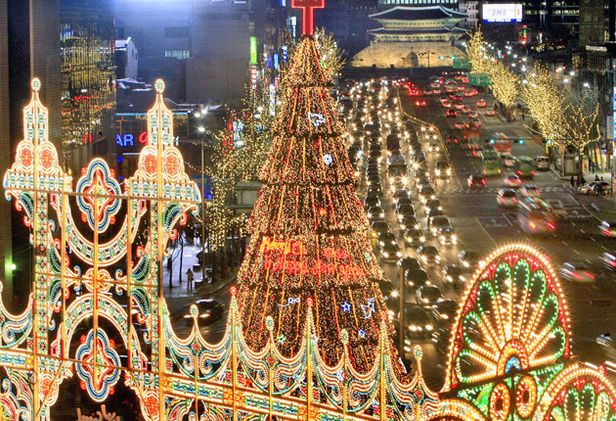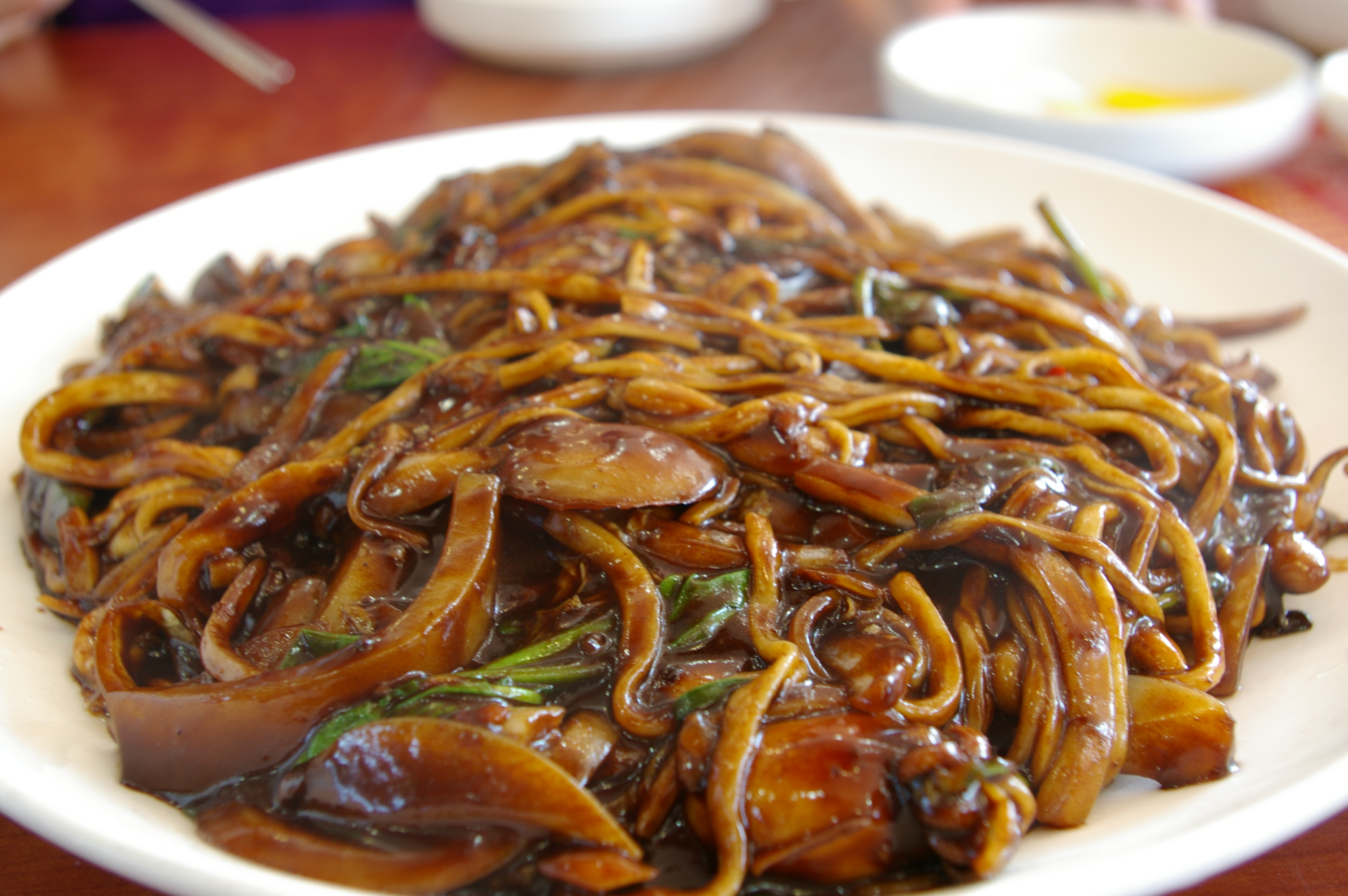Hi everyone! Our group has put together this video to demonstrate Cultural Celebrations in our society, enjoy!
Cultural Celebrations
Tuesday, 28 May 2013
Sunday, 5 May 2013
A Korean Christmas
Christmas falls on the 25th of December in Korea; just like everywhere else. Christianity is quite young in Korea compared to other nations, with only 2% of the population identifying with the religion in 1945 after almost 200 years of contact from western missionaries. However, following the end of World War II in 1945 and Korea's independence from Japanese occupation, Christianity saw a rapid growth in Korea with the total percentage of Christians in South Korea today being 29.2%. Therefore, it is no surprise that Christmas is celebrated as a religious event, as well as a social one (the majority of the population is non-religious).
Christmas sees many services held across churches in Korea in the days leading up to the 25th; Protestant and Catholic alike. For the Christian family, Christmas is a time to come together to celebrate Christ's birth as well as wishing good cheer and blessings. However, unlike western traditions, Christmas doesn't hold as strong an emphasis on the family coming together. Rather, Christmas, like Halloween, has been adopted as a key day on the calendar for couples and love; which isn't so surprising considering the nation's obsession with romance.
Christmas in big cities such as Seoul and Busan will see immense displays of decorative lights. Every shop, cafe, and building will be lined with festive decorations and of course, have an endless stream of Christmas songs. Even the many bridges that link the banks of the Han river in Seoul are decked with festive lights. It is customary for the exchanging of gifts to occur, and to celebrate with a 'Christmas cake' which would be purchased from your local bakery or cafe.
In short, Christmas is a most festive occasion in Korea for the young and old; the religious and non-religious. It is celebrated with food, company, and a break from the long work hours of South Korea.
-David
Sources:
http://seoulbeats.com/wp-content/uploads/2012/12/20121212_seoulbeats_xmas3.jpg
http://farm9.staticflickr.com/8352/8303951912_778049287c_z.jpg
https://blogger.googleusercontent.com/img/b/R29vZ2xl/AVvXsEjiULgLw1kuBrizRBwekUvNE7mHcWjmIHsEystmNDU540AH4wxx9WDGcWdU22F6QPio3EhGK5AyVh86E1iWCTBMHlOW-kQo8IYc6c7icEIGF8RSAa25O-STtpTLtslM-xcBZwqqRY_y4mY/s320/IMG_3051-.jpg
Sources:
http://seoulbeats.com/wp-content/uploads/2012/12/20121212_seoulbeats_xmas3.jpg
http://farm9.staticflickr.com/8352/8303951912_778049287c_z.jpg
https://blogger.googleusercontent.com/img/b/R29vZ2xl/AVvXsEjiULgLw1kuBrizRBwekUvNE7mHcWjmIHsEystmNDU540AH4wxx9WDGcWdU22F6QPio3EhGK5AyVh86E1iWCTBMHlOW-kQo8IYc6c7icEIGF8RSAa25O-STtpTLtslM-xcBZwqqRY_y4mY/s320/IMG_3051-.jpg
Friday, 3 May 2013
Rakhi (the bond of protection)
Rakhi, or Raksha Bandhan, is a tradition and festival in India carried out by Hindus to celebrate the special relationships between siblings and cousins.
The mythology of Rahki comes from the notion that Ganesh had two sons, Shubh and Labh. On Raksha Bandhan, Ganesh's sister visited and tied a rakhi on his wrist. Thus, as tradition, the Hindu tradition marks this celebration annually coinciding with the full moon "Purnima"
The Rakhi is a sacred thread that represents brotherhood and is tied around the wrists by the sister to symbolise love and hope for the brother's wellbeing. The rakhi can also be tied for those who we may consider our brothers but have no genetic relation to, providing that the commitment is made for life along as they obtain the obligation to provide protection to the "sister".
The brothers present their sisters with an envelope containing money or presents such as saris.
 Sweets are also a customary tradition of Rahki. Usually is fed to each other between siblings.
Sweets are also a customary tradition of Rahki. Usually is fed to each other between siblings.

The holy rahki thread comes in a variety of colours and styles
Rahki can be tied for siblings of all ages as seen in the pictures. The colours are bright and vibrant.

 - Madhu
- Madhu
REFERENCES
For Pictures (In Order):
Pahiyas Festival
 Pahiyas Festival is a bright and
beautiful feast which occurs on the 15th of May by locals of Lucban,
Quezon, commemorating the San Isidro Labrador, as well as farmers’ thanks for a
bountiful harvest. The celebration itself has been celebrated all the way back
to the 16th century, and legend was that San Isidro Labrador would
magically plow the farmer’s crop whenever he left the local church. There is a
vibrant array of colors displayed in the festival using various fruits,
vegetables, and hand-crafted items in every house in town.
Pahiyas Festival is a bright and
beautiful feast which occurs on the 15th of May by locals of Lucban,
Quezon, commemorating the San Isidro Labrador, as well as farmers’ thanks for a
bountiful harvest. The celebration itself has been celebrated all the way back
to the 16th century, and legend was that San Isidro Labrador would
magically plow the farmer’s crop whenever he left the local church. There is a
vibrant array of colors displayed in the festival using various fruits,
vegetables, and hand-crafted items in every house in town.
In the parade itself, there are a
lot of customs:
- A procession, with big papier mâché statues of a farmer and his wife, followed by a patron saint, with a basket that holds biscuits to be given to children
- Streets and homes are decorated with the seasons harvest, including fruits, vegetables, rice grains/stalks, flowers, ferns and rice wafers
- A competition to see whose home is the most creatively decorated, of which the decorations of the house will be taken down to be fed to festival-goers for free
·
Displaying of harvest so that the local parish
priest may “bless” the food as the procession passes by
-Patrick
Sources of Images:
Thursday, 2 May 2013
The Four 'Romantic Holidays'
In the calendar year, there are four 'romantic' days for Koreans in the modern age. These days do not have long cultural histories for most of them were established during the 20th century.
The first of the four is Valentine's Day which is just like the ones held around the world on the 14th of February except with a tweaked focus of the girls presenting their romantic interest or significant other with chocolate and gifts. However, it is not a rule set in stone and some couples and individuals choose to celebrate the day in the more common way.
The second of the four is White Day on the 14th of March. It is the reverse of Valentine's Day in that it is the guys' turn to either return the 'proposed' affection on Valentine's with chocolate and gifts on White Day. For people in relationships, it would just be a 'second half' to the 2-part series.
The third of the four is Black Day which is held on the 14th of April. It is a Singles Awareness Day of sorts in Korea, as it is a day for singles who did not receive gifts on either Valentine's or White Day. The tradition is that singles would meet or go out to eat jjajangmyeon (짜장면), white Korean noodles with black bean sauce, to either celebrate or hold back the sorrows of singledom.
The fourth and last is Pepero Day held on the 11th of November (11/11). It is named after the snack cookie sticks and falls on the particular day as 11/11 resembles four Pepero sticks in a row. It is like Valentine's and White Day in that confectionary and gifts are exchanged and gifted; but with the factor of no limitations of whose 'turn' it is.
These four holidays are very commercial in nature, and are observed mainly by the younger population of Korea; which is the majority of the population considering the high majority of the population are under the age of 50.
-David
Sources:
http://1.bp.blogspot.com/-V6JcuZt_GP0/TViN55yE2aI/AAAAAAAACdk/7NjbekLWdiY/s320/heart.jpg
http://www.todayandtomorrow.net/wp-content/uploads/2008/03/louis_vuitton.jpg
http://upload.wikimedia.org/wikipedia/commons/a/a0/Korean_black_bean_noodle_dish-Jaengban_Jajangmyeon-01.jpg
http://adventureteachingkorea.files.wordpress.com/2010/11/pepero.jpg
Sources:
http://1.bp.blogspot.com/-V6JcuZt_GP0/TViN55yE2aI/AAAAAAAACdk/7NjbekLWdiY/s320/heart.jpg
http://www.todayandtomorrow.net/wp-content/uploads/2008/03/louis_vuitton.jpg
http://upload.wikimedia.org/wikipedia/commons/a/a0/Korean_black_bean_noodle_dish-Jaengban_Jajangmyeon-01.jpg
http://adventureteachingkorea.files.wordpress.com/2010/11/pepero.jpg
Wednesday, 1 May 2013
Diwali (Festival of Lights)
Diwali (Festival of Lights)
 Diwali (or Deepavali) is India's most known and celebrated event.
Diwali (or Deepavali) is India's most known and celebrated event.Diwali is an official holiday in India, Nepal, Sri Lanka, Myanmar, Mauritis, Guyana, Trinidad & Tobago, Suriname, Malaysia, Singapore and Fiji.
This Hindu celebration is known as the "festival of lights"as Diwali/Deepavali roughly translates to "row of lamps". The celebration involves lighting small clay lamps filled with oil to mark the triumph of good over evil. This celebration also involves the lighting of fireworks "crackers". The liveliness of lights are represented through the lamps and fireworks which are believed to drive evil away.
In Australia it may not be as celebrated, in large part due to the availability... although the fireworks are fun and exciting to use, such fireworks are definitely not sold here in Australia due to safety hazards.
Along with fireworks, at Diwali people buy new clothes as well as share and eat snacks and sweets with family and friends.
During the Diwali celebrations, the streets and rooftops of India are filled with people lighting fireworks that they bought from the many shops that sell them at the time.
With over 1billion people living in India, every celebration is like a giant community function.
The last time i was in India during Diwali was an unforgettable moment, we left India during the final moments of Diwali at 2am and the streets were still filled with people celebrating. The traffic was held up by one person who decided to put a long line of "Pattass" (fireworks) across the road which took a full 5 minutes to finish!
Here are some commonly used types of fireworks during Diwali...
 My personal favorite Diwali firework to light is the "Chakri"/"Chakra". This one spins when you light it! In the picture (left) the chakri is the round flat firework.
My personal favorite Diwali firework to light is the "Chakri"/"Chakra". This one spins when you light it! In the picture (left) the chakri is the round flat firework. (Below) This is a video on how the chakri works/looks when lit:
[YouTube - http://www.youtube.com/watch?v=hG-s9VXwDCI]
As well as being a fun holiday and celebration, Diwali also marks a holy day in which celebrants show their part in being good and fighting over evil. It allows people to celebrate and have fun and shows the beauty of light in being symbolic of good heartedness.

(Left) The bigger fireworks in the sky.
- Madhu
REFERENCES
For Pictures (In order of use):
http://www.cellubeauty.com/wp-content/uploads/2012/11/105417-ankita-lokhande-wishes-happy-diwali1.jpg
http://orgs.unt.edu/isa/events/diwali.jpg
http://www.indolinks.com/websights/diwali/crackers1.jpg
http://prasanthblog.com/wp-content/uploads/2012/11/fireworks2012.jpg
For Video:
http://www.youtube.com/watch?v=hG-s9VXwDCI
Tuesday, 30 April 2013
Sinulog Festival
Sinulog Festival is a yearly
festival on the third Sunday of January in Cebu City, and a few others. It
commemorates Filipino’s pagan origin, Roman Catholocism, and Santo Nino (a
vested statue of a child Jesus).
The Festivals themselves consists
of streets filled with parades and decorations, colourful costumes, lots of
dancing and music (ranging from drums to trumpets, and to native gongs)
prepared by different groups. It lasts for 9 days, and everything leads up to
the Grand Parade.
The “Fluvial Procession” is held
at dawn with a statue of Santo Nino, the day before the parade.
The Grand Parade culminates all
the festivities that occur throughout the nine days, and also include a variety
of competitions for performers and dancers of different types.
The word “Sinulog” is derived
from the Cebuano adverb “Sulog” which roughly means, “to move like water”,
which is intended to describe the forward-backward nature of the dance.
-Patrick
Sources of Images:
Subscribe to:
Comments (Atom)





.jpg)
.jpg)






.jpg)
.jpg)